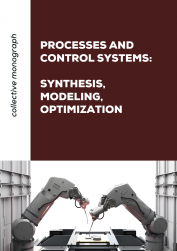Technological aspects of computer control of the secondary condensation complex of ammonia production under uncertainty
Keywords:
mathematical modelling, computer-integrated technology, optimal software controlAbstract
The object of study is a technological complex of secondary condensation (TCS) of large-capacity ammonia synthesis units of AM-1360 series, which provides final cooling and separation of condensed product ammonia from circulating gas (CG). The possibility of increasing the energy efficiency of production by modernising the equipment and technological design of the TACC was established. This is achieved by removing an energy-intensive electrically driven turbo-compressor refrigeration unit (TCRU) from the scheme and creating an adaptive system of optimal software control.
The expediency of applying a systematic approach to solving such a complex problem, the scientific basis of which is mathematical modelling and process identification, is shown. The peculiarities of the operating conditions of the TKVK and the primary condensation unit are analysed. The research results revealed uncertainties in the functioning of such components as the condensing column (CC) and low-temperature evaporators (LTE), which are connected to the operation scheme of two absorption-cooling units (ACU) and the ATC.
The algorithms for generating an information array of experimental data and numerical estimation of uncertainties, in particular, heat transfer coefficients in the BF and LST, as well as ammonia concentration at the outlet of the primary condensation unit and the BF, were developed. The algorithms provide for the separation of transient modes in the operation of the TKVK, verification of stationarity, reproducibility of the process and the hypothesis of the normality of the empirical distribution, which makes it possible to use a stochastic approximation method for numerical estimation of uncertainties.
Based on the results of processing the experimental data, a discrepancy between the real and design heat transfer coefficients was found, which is due to an underestimation of the condensation thermal resistance. The heat transfer processes in the BF and CNT as part of the CCS were identified and equations were obtained to determine the heat transfer coefficients, heat transfer, condensation thermal resistance, and ammonia concentration in the GHG at the inlet and outlet of the BF.
The conditions of the required temperature distribution in the TCWC to exclude it from the ATC scheme and reduce the DH cooling temperature in the HST by 5 °C compared to the original variant at the maximum DH heat load at the inlet of the complex were determined by mathematical modelling. The developed scheme of the TACC is characterised by greater energy efficiency due to the use of only heat-using refrigeration systems of AHU and steam generating units (SGU), which utilise the heat of material flows of both low temperature potential (up to 150 °C) and ultra-low (up to 90 °C).
Using the method of mathematical modelling of the VNT, the regularity of the extreme nature of the dependence of the cooling capacity and cooling temperature of the DH on the phlegm flow rate was established. The achievement of the maximum cooling capacity, and hence the minimum cooling temperature of the DH at a certain temperature head, is due to the critical mode of bubble boiling of the refrigerant. The dependencies of the DH cooling temperature on the controlling effect of the phlegm flow rate are determined, which characterise the shift of the extremum under conditions of changing the coordinates of the perturbation vector, and hence the change in the energy efficiency of ammonia production (annual natural gas consumption).
Algorithmic software was developed to solve the problems of identification, obtaining a mathematical model of the CNT evaporator and numerical estimation of the optimal state vector (cooling temperature of the DH). The use of the algorithm implemented in the MatLab package ensures the solution of the optimisation problem in real time by a gradient-free stepwise method using one-dimensional extremum search methods.
The technical structure of a computer-integrated system for optimal software control of the temperature regime of a low-temperature evaporator, adapted to the existing information system of an industrial synthesis unit, has been determined.

In press. PROCESSES AND CONTROL SYSTEMS: SYNTHESIS, MODELING, OPTIMIZATION
Published
Categories
License

This work is licensed under a Creative Commons Attribution-NonCommercial-NoDerivatives 4.0 International License.

